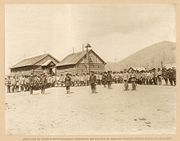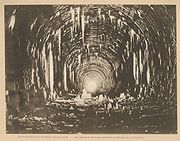
Amur Railway
Encyclopedia

Russian gauge
In railway terminology, Russian gauge refers to railway track with a gauge between 1,520 mm and . In a narrow sense as defined by Russian Railways it refers to gauge....
Amur Railway is the last section of the Trans-Siberian Railway
Trans-Siberian Railway
The Trans-Siberian Railway is a network of railways connecting Moscow with the Russian Far East and the Sea of Japan. It is the longest railway in the world...
in Russia
Russia
Russia or , officially known as both Russia and the Russian Federation , is a country in northern Eurasia. It is a federal semi-presidential republic, comprising 83 federal subjects...
, built in 1906-1916. The construction of this railway favored the development of gold mining
Gold mining
Gold mining is the removal of gold from the ground. There are several techniques and processes by which gold may be extracted from the earth.-History:...
industry, logging
Logging
Logging is the cutting, skidding, on-site processing, and loading of trees or logs onto trucks.In forestry, the term logging is sometimes used in a narrow sense concerning the logistics of moving wood from the stump to somewhere outside the forest, usually a sawmill or a lumber yard...
, fishery
Fishery
Generally, a fishery is an entity engaged in raising or harvesting fish which is determined by some authority to be a fishery. According to the FAO, a fishery is typically defined in terms of the "people involved, species or type of fish, area of water or seabed, method of fishing, class of boats,...
, and fur trade
Fur trade
The fur trade is a worldwide industry dealing in the acquisition and sale of animal fur. Since the establishment of world market for in the early modern period furs of boreal, polar and cold temperate mammalian animals have been the most valued...
in Siberia
Siberia
Siberia is an extensive region constituting almost all of Northern Asia. Comprising the central and eastern portion of the Russian Federation, it was part of the Soviet Union from its beginning, as its predecessor states, the Tsardom of Russia and the Russian Empire, conquered it during the 16th...
and Russian Far East
Russian Far East
Russian Far East is a term that refers to the Russian part of the Far East, i.e., extreme east parts of Russia, between Lake Baikal in Eastern Siberia and the Pacific Ocean...
. It is over 2115 km in length, stretching across the Transbaikal
Transbaikal
Transbaikal, Trans-Baikal, Transbaikalia , or Dauria is a mountainous region to the east of or "beyond" Lake Baikal in Russia. The alternative name, Dauria, is derived from the ethnonym of the Daur people. It stretches for almost 1000 km from north to south from the Patomskoye Plateau and North...
Region and Amur Oblast
Amur Oblast
Amur Oblast is a federal subject of Russia , situated about east of Moscow on the banks of the Amur and Zeya Rivers. It shares its border with the Sakha Republic in the north, Khabarovsk Krai and the Jewish Autonomous Oblast in the east, People's Republic of China in the south, and Zabaykalsky...
. The railway's main sections are: Kuenga-Uryum (204 km, 1907-1911); Uryum-Kerak (632 km, 1909-1913); Kerak-Deya with an offshoot to Blagoveshchensk
Blagoveshchensk
Blagoveshchensk is a city and the administrative center of Amur Oblast, Russia. Population: -Early history of the region:The early residents of both sides of the Amur in the region of today's Blagoveshchensk were the Daurs and Duchers...
(679 km, 1911-1915); Deya-Khabarovsk
Khabarovsk
Khabarovsk is the largest city and the administrative center of Khabarovsk Krai, Russia. It is located some from the Chinese border. It is the second largest city in the Russian Far East, after Vladivostok. The city became the administrative center of the Far Eastern Federal District of Russia...
(481 km, 1915-1916). Ye.Yu.Podrutsky, Alexander Liverovsky, and V.V.Tregubov were the chief engineers, who oversaw the construction of the Amur Railway by approx. 54,000 workers (as of 1913), brought from Central Russia and Siberia (tsarist government specifically forbade the use of foreign workforce).
Construction

Pyotr Stolypin
Pyotr Arkadyevich Stolypin served as the leader of the 3rd DUMA—from 1906 to 1911. His tenure was marked by efforts to repress revolutionary groups, as well as for the institution of noteworthy agrarian reforms. Stolypin hoped, through his reforms, to stem peasant unrest by creating a class of...
. On April 3 of 1908, they issued a decree "On Commencement of the Construction of the Amur Railway by the Order of and at the Expense of the State". The construction itself took place in scarcely populated permafrost
Permafrost
In geology, permafrost, cryotic soil or permafrost soil is soil at or below the freezing point of water for two or more years. Ice is not always present, as may be in the case of nonporous bedrock, but it frequently occurs and it may be in amounts exceeding the potential hydraulic saturation of...
areas under harsh climatic conditions. Construction sites were divided into western, middle, and eastern sections. In 1907-1913, they built the western section of the railway from Kuenga to Uryum. First, the engineers had to connect the Shilka
Shilka River
Shilka is a river in Zabaykalsky Krai, south-eastern Russia. It has a length . It originates as a confluence of the Onon and Ingoda rivers. Its confluence with the Ergune on the Russia-China border gives rise to the Amur River. The river is navigable for its entire length....
and the Amur with the railroad under construction in order to be able to deliver material and workforce. They had to build a temporary road in the swampy middle section of the future Amur Railway for the purpose of delivering the foundation. Often, the whole finished parts of the road would disappear in the swamps. In 1912, a talented engineer Alexander Liverovsky was put in charge of the construction of the eastern section of the Amur Railway. For the first time in railroad construction, earth-moving works were mechanized. The workers used ten excavator
Excavator
Excavators are heavy construction equipment consisting of a boom, stick, bucket and cab on a rotating platform . The house sits atop an undercarriage with tracks or wheels. A cable-operated excavator uses winches and steel ropes to accomplish the movements. They are a natural progression from the...
s and several machines for mortar
Mortar (masonry)
Mortar is a workable paste used to bind construction blocks together and fill the gaps between them. The blocks may be stone, brick, cinder blocks, etc. Mortar becomes hard when it sets, resulting in a rigid aggregate structure. Modern mortars are typically made from a mixture of sand, a binder...
mixing and rock grinding. Also, they built a number of repair shops and sawmills, therefore, there was no need to transport railroad tie
Railroad tie
A railroad tie/railway tie , or railway sleeper is a rectangular item used to support the rails in railroad tracks...
s and squared timber to construction sites. In 1914, the western and eastern sections of the Amur Railway came together at the Obluchye railway station, making it possible for trains to go through.
Interesting facts about the Amur Railway
The Amur Railway is known for its unique man-made structures, such as the Khabarovsk BridgeKhabarovsk Bridge
Khabarovsk Bridge is a road and rail bridge built in 1999. It crosses the Amur River in eastern Russia, and connects the urban-type settlement of Imeni Telmana in the Jewish Autonomous Oblast, and city of Khabarovsk in the Khabarovsk Krai...
over the Amur River (considered the longest in Imperial Russia, Soviet Union
Soviet Union
The Soviet Union , officially the Union of Soviet Socialist Republics , was a constitutionally socialist state that existed in Eurasia between 1922 and 1991....
, and Eurasia
Eurasia
Eurasia is a continent or supercontinent comprising the traditional continents of Europe and Asia ; covering about 52,990,000 km2 or about 10.6% of the Earth's surface located primarily in the eastern and northern hemispheres...
for decades; designed by Lavr Proskuryakov
Lavr Proskuryakov
Lavr Dmitrievich Proskuryakov was a leading bridge builder of Imperial Russia.Proskuryakov was responsible for many bridges constructed along the Trans-Siberian Railway, including the one crossing the Kotorosl River in Yaroslavl , another spanning the Yenisey near Krasnoyarsk and the Khabarovsk...
) and the first permafrost tunnel
Tunnel
A tunnel is an underground passageway, completely enclosed except for openings for egress, commonly at each end.A tunnel may be for foot or vehicular road traffic, for rail traffic, or for a canal. Some tunnels are aqueducts to supply water for consumption or for hydroelectric stations or are sewers...
in the world with the use of insulation
Thermal insulation
Thermal insulation is the reduction of the effects of the various processes of heat transfer between objects in thermal contact or in range of radiative influence. Heat transfer is the transfer of thermal energy between objects of differing temperature...
between its outer surface and the rock. At the suggestion of Alexander Liverovsky, the engineers devised a method of building piers with the use of heated concrete
Concrete
Concrete is a composite construction material, composed of cement and other cementitious materials such as fly ash and slag cement, aggregate , water and chemical admixtures.The word concrete comes from the Latin word...
in below-zero weather conditions. They also built railway stations, railroad workshops, elementary schools, and hospitals along the Amur Railway. Before the bridge was operational, they had arranged a train ferry
Train ferry
A train ferry is a ship designed to carry railway vehicles. Typically, one level of the ship is fitted with railway tracks, and the vessel has a door at the front and/or rear to give access to the wharves. In the United States, train ferries are sometimes referred to as "car ferries", as...
in summertime and horse-drawn train platforms to cross the icebound Amur River in wintertime. In 1912, the government began issuing up to 400 rubles in allowance and necessary household articles to those workers, who had decided to settle down in this region.
The Amur Railway was put under the authority of the Ministry of Communications
Ministry of Communications
Ministry of Communications may refer to:* Ministry of Communications * Ministry of Communications * Ministry of Communications * Ministry of Communications of Morocco...
with its administration in Khabarovsk. In 1922, the railway was transferred under the authority of the People's Commissariat for Communications (Народный Комиссариат Путей Сообщения). In 1959, the Amur Railway and the Transbaikal section of the Transsib were merged to form the Transbaikal Railway.
The construction of the Amur Railway finished before the outbreak of the World War I
World War I
World War I , which was predominantly called the World War or the Great War from its occurrence until 1939, and the First World War or World War I thereafter, was a major war centred in Europe that began on 28 July 1914 and lasted until 11 November 1918...
and cost over 250,000 million ruble
Ruble
The ruble or rouble is a unit of currency. Currently, the currency units of Belarus, Russia, Abkhazia, South Ossetia and Transnistria, and, in the past, the currency units of several other countries, notably countries influenced by Russia and the Soviet Union, are named rubles, though they all are...
s. The eastern section of the railroad alone cost 73 million rubles. A famous Norwegian
Norway
Norway , officially the Kingdom of Norway, is a Nordic unitary constitutional monarchy whose territory comprises the western portion of the Scandinavian Peninsula, Jan Mayen, and the Arctic archipelago of Svalbard and Bouvet Island. Norway has a total area of and a population of about 4.9 million...
explorer and geographer Fridtjof Nansen
Fridtjof Nansen
Fridtjof Wedel-Jarlsberg Nansen was a Norwegian explorer, scientist, diplomat, humanitarian and Nobel Peace Prize laureate. In his youth a champion skier and ice skater, he led the team that made the first crossing of the Greenland interior in 1888, and won international fame after reaching a...
referred to the Trans-Siberian Railway as the "technical wonder". Its construction favored rapid development of formerly backward regions of Siberia and Far East.

